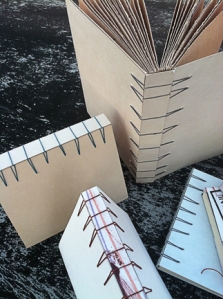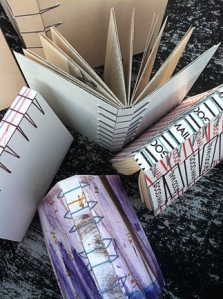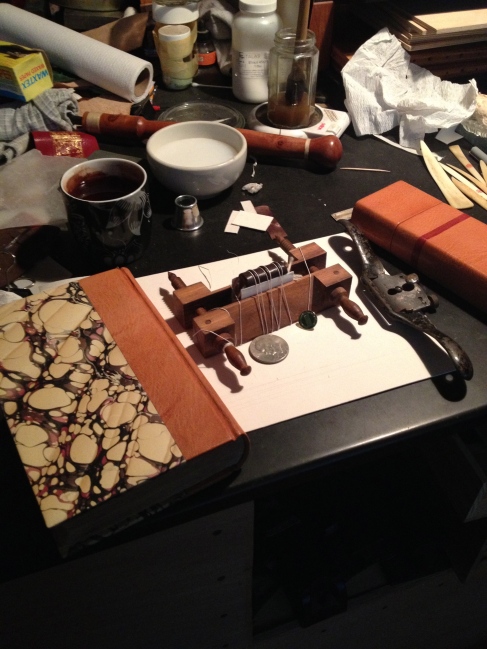Jennie Hinchcliff will be teaching two classes:
Structures With Style: Secret Belgian Binding Class – March 9, 2013
10:00 am – 5:00 pm$120 + 20 materials fee (must bring to class)
Creative Caterpillar Binding Class – March 23, 2013
10:00 am – 5:00 pm $120 + 20 materials fee (must bring to class)
Jennie’s a lot of fun & is a talented ball of fire. I had the pleasure of working with her when I taught at the SFCB and then when we were on the board of the Pacific Center For Book Arts. I keep thinking up things to do with her because she’s always got a great attitude and comes up with great ideas and projects.
I wrote Jennie a few questions that seemed pertinent to let students know what kind of teacher they would encounter in these great classes. Of course, I wanted to be serious.
Why are you a book artist/postal modern, instead of the ruler of the free world?
“Ruler of the Free World” is a great title to put on the ol’ CV, but it seems like a straight up 9-5 job…I’m pretty attached to keeping my own hours.
Did you ever think you’d be making a living by making art?
I can’t imagine how else I’d be making a living, to tell you the truth.
What is it about mail-art that fascinates and enthralls you?
I love the whole philosophy of mail art: anyone can take part, that it can be as simple or as complicated as one wants and people exchange with each other because they want to — not out of obligation. Mail art goes far beyond being passionate about the USPS, although that definitely plays a part. The artists and letter writers I’ve met through the mail art Network are incredibly creative; I feel so fortunate to correspond with the likes of Cascadia ArtPost, John Held, Jr., Reed Altemus, Sally Wurlitzer…there are too many to name, all truly talented artists. Every time I stop by my PO box, it’s like Christmas and my birthday all rolled into one. Mail artists have a saying, that “the mailbox is a museum” and it’s oh-so-true.
When did you know that making books and doing mail-art wasn’t just a passing fancy?
I’ve always made things with my hands; as a kid I would make little books and fill them with goofy stories. My grandmother and I would make origami animals or glue up collages — things like that. I was first introduced to mail art when I checked out the book “SWAK: The Complete Book of Mail Fun for Kids” by Randy Harelson from my grade school library; as a fifth grader, I couldn’t believe that there was a community of people who sent wacky things to each other through the mail. Because things like paper, postage, and books are so much a part of who I am, I never considered them as passing fancies.
What is your five-year plan for changing the world through your artistic endeavors?
Well, I can neither confirm nor deny that my five year plan is currently in effect. But I can tell readers of the Biblioforge blog that the plan-which-shall-not-be-named will involve plenty of stamps (postage AND rubber!), lots of postcards, and a workshop or three. There might even be an artist book series and a postmaster thrown in for good measure.
Will you show mercy on the congressional ogres that keep undermining the good in the USPS once you’ve taken control?
(Taking a deep breath, stepping away from the soapbox) I think that every lawmaker who has had a hand in decimating the USPS should have their Saturday delivery service taken away and their free mailing/postal privileges revoked. This would be a step in the right direction towards awareness of how important the USPS is to individuals, as well as the country. Fact: the current USPS vs. the US government situation is confusing, but anyone who uses the postal system should understand the basics of how this happened. And then, I would invite Biblioforge readers to sign the “The Post Office Isn’t Broke, It’s Being Robbed” petition.
Final thoughts?
I’m looking forward to teaching at Biblioforge in March! Workshops are one of my favorite ways to meet new folks who are enthusiastic about making books. I love skill sharing with students, seeing that “aha!” moment occur when someone “gets it” as far as learning a new book structure is concerned. After all, there’s no substitute for holding a “real” book in your hands: turning the pages at your own pace, feeling the paper. And if you’ve made that book yourself? Well, there’s truly nothing like it.
Jennie Hinchcliff currently teaches book arts classes in Fine Art Department at the Academy of Art University, as well as numerous workshops nationally and locally. You can follow her postal adventures at: http://redletterdayzine.wordpress.com/











